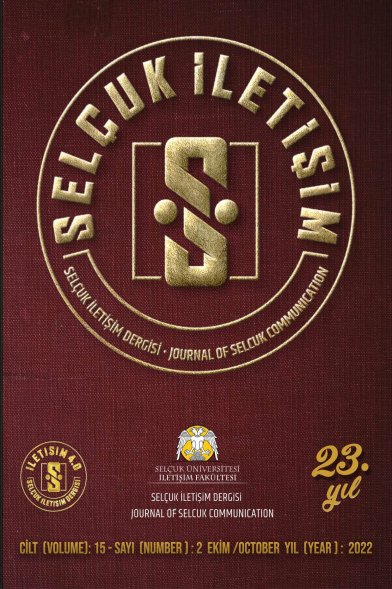Genetiği değiştirilmiş organizmalara ilişkin tartışmaların Türk basınında çerçevelenmesi
Framing the debates regarding to genetically modifield organisms in the Turkish press
___
- Augoustinos M, Crabb S ve Shepherd R (2010) Genetically Modified Food in the News: Media Representations of the Gm Debate in the UK, Public Understanding of Science, 19(1), 98- 114.
- Bickerstaff K, Lorenzoni I, Pidgedon N F, Poortinga W ve Simmons P (2008) Reframing nuclear power in the UK Energy Debate: Nuclear Power, Climate Change Mitigation And Radioactive Waste, Public Understanding of Science, 17, 514-533.
- Brasted M (2005) Framing protest: The Chicago Tribune and the New York Times during the 1968 democratic convention, Atlantic Journal of Communication, 13, 1-25.
- Conrad P (2001) Genetic Optimism: Framing Genes and Mental Illness in the News, Culture, Medicine and Psychiatry, 25 (2), 225-247.
- Cook G, Robbins P T ve Pieri E (2006) “Words of Mass Destruction”: British Newspaper Coverage of the Genetically Modified Food Debate, Expert and Non-Expert Reactions, Public Understanding of Science, 15 (1), 5-29.
- de Vreese C H (2005) News Framing: Theory and Typology, Information Design Journal+Document Design, 13(1), 51-62.
- Dağtaş E (2006) Türkiye’de Magazin Basını, Ütopya Yayınevi, Ankara.
- Edy J A ve Meirick P C (2007) Wanted, Dead or Alive: Media Frames, Frame Adoption, and Support for the War in Afghanistan, Journal of Communication, 57 (1), 119-141.
- Entman R M ve Rojecki A (1993) Freezing Out the Public: Elite and Media Framing of the U.S. Anti-Nuclear Movement, Political Communication, 10, 155-173.
- Entman R M (1993) Framing: Toward Clarification of a Fractured Paradigm, Journal of Communication, 43(4), 51-58.
- Entman R M (1991) Framing U.S. Coverage of International News: Contrast in Narratives of the KAL and Iran Air Incidents, Journal of Communication, 41(4), 6-27.
- Iyengar S (1989) How Citizens Think About National Issues: A Matter of Responsibility, American Journal of Political Science, 33 (4), November.
- Listerman T (2010) Framing of Science Issues in Opinion-leading News: International Comparison of Biotechnology Issue Coverage, Public Understanding of Science, 19(1), 5-15.
- Marks L A, Kalaitzandonakes N, Wilkins L ve Zakharova, L (2007) Mass Media Framing of Biotechnology News, Public Understanding of Science, 16 (2), 183-203.
- Scheufele D A ve Tewksbury D (2007) Framing, Agenda Setting, and Priming: The Evolution of Three Media Effects Models, Journal of Communication, 57 (1), 9-20.
- Scheufele D A (1999) Framing as a Theory of Media Effects, Journal of Communication, 103-122.
- Schütz H ve Wiedamann P M (2008) Framing Effects on Risk Perception of Nanotechnology, Public Understanding of Science, 17 (3), 369- 379.
- Simon A ve Xenos M (2000) Media Framing and Effective Public Deliberation, Political Communication, 17, 363-376.
- Tiryaki İ ve Acar Z (2005) Genetik Yapısı Değiştirilmiş Bitkiler: Dünü, Bugünü ve Geleceği, OMÜ Zir. Fak. Derg, 20 (2), 121-126.
- Van Gorp B V (2007) The Constructionist Approach to Framing: Bringing Culture Back In, Journal of Communication, 57 (1), 60-78.
- Weaver D H (2007) Thoughts on Agenda Setting, Framing and Priming, Journal of Communication, 57, 142-147.
- Zhou Y ve Moy P (2007) Parsing Framing Processes: The Interplay Between Online Public Opinion and Media Coverage, Journal of Communication, 57 (1), 79-98.
- Yayın Aralığı: Yılda 2 Sayı
- Başlangıç: 1999
- Yayıncı: Selçuk Üniversitesi İletişim Fakültesi
Televizyon reklamlarında okul çağı çocuklarının besin seçimi üzerine etkilerinin bir incelemesi
HÜRRİYET A.Ş. ÖRNEĞİNDE YENİ MEDYA SEKTÖRÜ VE ÇOKULUSLAŞMA PRATİKLERİNİN TEMEL EĞİLİMLERİ*
Genetiği değiştirilmiş organizmalara ilişkin tartışmaların Türk basınında çerçevelenmesi
DEMOKRAT PARTİ'NİN 1946 - 1950 YILLARI ARASINDAKİ HALKLA İLİŞKİLER STRATEJİLERİ
Makbule GÜLSÜNLER, Hülya ERTÜRK
Medya okuryazarlığı araştırması ve Selçuk Üniversitesinde bir uygulama
Televizyon reklamlarında aileye ilişkin değerlerin temsili
ALTHUSSER'İN GÖZÜNDEN İDEOLOJİ VE İDEOLOJİNİN BİR TAŞIYICISI OLARAK YENİ MEDYA
Demokrat parti'nin 1946-1950 yılları arasındaki halkla ilişkiler stratejileri
Hülya ERTÜK ANAKIZ, Evrim Makbule GÜLSÜNLER
Sosyal medyada 2011 genel seçimleri: Nicel - nitel arayüzey incelemesi
Burak DOĞU, Tuğrul ÇOMU, Gözde İSLAMOĞLU, Mutlu BİNARK, Aslı AYDEMİR TELLİ, Günseli BAYRAKTUTAN
